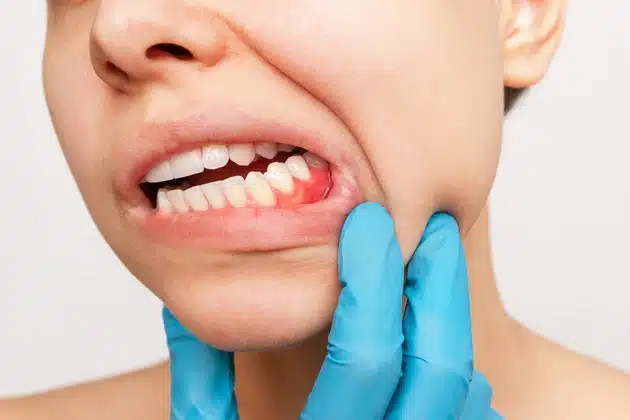
Dentleon İzmir Bornova, Çiğli, Güzelbahçe, Bayraklı Özel Diş Kliniği
What is a Canker Sore, What Causes Canker Sores and How Are They Treated?
17 July 2025

What is a Canker Sore, What Causes Canker Sores and How Are They Treated?
Canker sores are small, white or yellow sores with reddened edges that suddenly appear inside the mouth . These sores, known as “aphthous stomatitis” in medical literature, are quite common. They are usually harmless but can negatively impact a person’s daily life.
The pain, especially when eating, drinking, or even talking, can disrupt a person’s social life and eating habits. While canker sores usually heal on their own within a short time, recurring or persistent canker sores can be a sign of other health problems, such as a weakened immune system, vitamin deficiencies, or hormonal imbalances.
What is Canker Sore?
Canker sores are small, painful sores that form in the soft, sensitive tissues inside the mouth. They are usually round or oval, with distinct red edges and a white or yellow center. They often have a whitish coating on their surface, and the underlying tissue is inflamed.
These sores typically range from 2 to 5 mm in diameter , but some people may experience larger sores that take longer to heal. Most commonly:
- On the inner surface of the cheek ,
- On the tongue or on the sides ,
- On the inner surface of the lip ,
- It occurs in the soft palate .
While canker sores usually appear singly, in some cases, multiple canker sores can develop simultaneously in the mouth. Stress, a weakened immune system, or oral trauma are particularly important factors that contribute to canker sores.
What is the difference between a canker sore and a cold sore?
Canker sores and herpes are often compared to each other, but in fact they are completely different in terms of their causes of formation, location and contagious characteristics .
- Cause:
Cold sores are caused by an infection caused by the herpes simplex virus (HSV-1) and can reoccur repeatedly once the virus becomes active. Canker sores, however, are not caused by any virus or bacteria; they are more often associated with a weakened immune system, oral trauma, stress, hormonal changes, or nutritional deficiencies. - Location:
Cold sores usually appear on the outer surface of the lips , sometimes around the nose or on the skin. Canker sores, on the other hand, appear inside the mouth , on the inner surface of the cheeks, tongue, palate, and lips. - Appearance:
Cold sores begin as small, fluid-filled blisters that eventually burst and crust over. Canker sores, on the other hand, appear as round or oval sores with a white or yellow center and red edges. - Contagiousness:
Cold sores are highly contagious and can be spread from person to person through kissing, sharing objects, etc. Canker sores are not contagious and are solely related to a person’s oral health and immune system.
In conclusion, both sores can be painful, but the treatment and prevention methods are different. Therefore, it’s important to carefully observe for a correct diagnosis rather than assuming every sore around the mouth is a cold sore.
In Which Areas Do Canker Sores Appear?
Canker sores tend to settle in the soft and sensitive tissues within the mouth. The most common areas are:
- Tongue:
Canker sores can appear on the upper surface, edges, or underside of the tongue. In these cases, pain is felt significantly when speaking, swallowing, and especially when consuming hot or cold foods. - Inner Cheek Surface:
The inner cheek surface, exposed to the pressure of teeth during chewing, is a vulnerable area for canker sores. Biting your cheek, eating hard foods, or rubbing against braces increases the risk of canker sores. - Inner Surface of the Lip:
Canker sores on the inner surface of the lip cause discomfort, especially when eating or moving the lips. - Soft Palate and Back of Throat:
Although less common, canker sores can occur on the soft palate or near the throat. In these cases, the pain when swallowing is more pronounced and can often be confused with a sore throat.
While canker sores usually appear as small, single sores, some people can develop multiple canker sores simultaneously . This is especially common in situations involving stress, vitamin deficiencies, or mechanical irritations such as braces.
What Causes Canker Sores?
While the exact cause of canker sores is unknown, it’s thought that many different factors are involved. Canker sores often occur as a result of a combination of factors.
Immune System Weakness
A weakened immune system is one of the most common conditions that predisposes to canker sores. Intense stress, lack of sleep, extreme fatigue, or chronic illnesses can negatively impact the immune system. When the immune system is weakened, the oral mucosa becomes sensitive, and even minor irritations can lead to canker sores.
Trauma and Mechanical Irritation
One of the most common causes of canker sores is trauma within the mouth. Harsh brushing, eating hard, sharp-edged foods, and accidentally biting the tongue or cheek can all trigger canker sores. For people with braces, friction between the braces and the cheek or tongue can be particularly common.
Vitamin and Mineral Deficiencies
Vitamin B12, iron, and folic acid deficiencies hinder the regeneration of oral mucosa, making canker sores more likely to form. Therefore, individuals with recurring canker sores are advised to review their diet and take vitamin supplements when necessary.
Hormonal Changes
Hormonal changes, particularly in women before or during menstruation, can trigger canker sores. Therefore, it’s common for women to experience an increase in canker sores during certain periods.
Allergic Reactions and Food Sensitivities
Certain foods can trigger canker sores. Acidic drinks and very spicy, salty, or hard foods, in particular, can irritate the oral mucosa and cause canker sores. In some people, allergic reactions to certain foods can also contribute to canker sores.
What are the symptoms of canker sores?
Canker sores usually appear with easily recognizable, distinctive symptoms:
- Round or Oval Sore in the Mouth: Canker sores are usually white or yellow in color and are surrounded by a distinct red halo around the edges.
- Pain and burning: Pain in the affected area increases, especially when eating, drinking hot or cold beverages, or talking. This pain can sometimes even make it difficult to move the tongue or jaw.
- Sensitivity: Even light touch in the area where the canker sore is present can be uncomfortable.
- Difficulty in Swallowing (In Large Canker Sores): Canker sores that appear near the throat or at the back of the tongue can cause significant pain while swallowing.
- General Weakness (In Rare Cases): In multiple and large aphthae, systemic symptoms such as mild fever, fatigue or weakness may also be observed.
These symptoms usually disappear on their own within 7-14 days. However, canker sores that recur frequently or take a long time to heal may be a sign of another underlying health problem.
How to Get Rid of Canker Sores?
Most canker sores heal on their own within 7-14 days. Antiseptic mouthwash, local anesthetic gels, and avoiding irritating foods can help.
How can canker sores be prevented?
Regular oral care, correcting vitamin deficiencies, managing stress, and chewing hard foods carefully can help prevent canker sores.
What Should Be Considered in Canker Sore Treatment?
It’s important to determine the cause of canker sores. Frequent or prolonged canker sores may indicate vitamin deficiencies, immune problems, or other illnesses.
When Do Canker Sores Become Dangerous?
Canker sores that last longer than two weeks, recur frequently, or are accompanied by general health symptoms such as fever and fatigue should be evaluated by a specialist.
Are Canker Sores Contagious?
Canker sores are not contagious because they are not caused by viral or bacterial causes.
How Many Days Does It Take for Canker Sores to Heal?
It usually heals on its own within 7-14 days, but this period may be longer for large or deep aphthae.
Recent Posts



